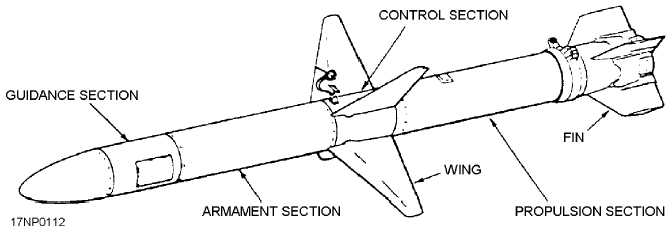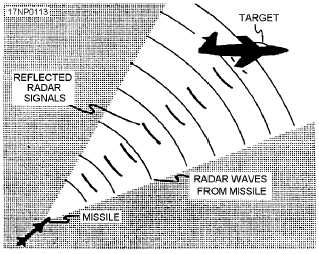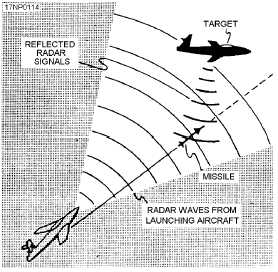There are a number of basic guidance systems used
in guided missiles. Homing-type, air-launched, guided
missiles are currently used. They use radar or infrared
homing systems.
A homing guidance system is one in which the
missile seeks out the target, guided by some physical
indication from the target itself. Radar reflections or
thermal characteristics of targets are possible physical
influences on which homing systems are based.
Homing systems are classified as active, semiactive,
and passive.
ACTIVE.—In the active homing system, target
illumination is supplied by a component carried in the
missile, such as a radar transmitter. The radar signals
(fig. 3-3) transmitted from the missile are reflected off
the target back to the receiver in the missile. These
reflected signals give the missile information such as
the target's distance and speed. This information lets the
guidance section compute the correct angle of attack to
intercept the target. The control section that receives
electronic commands from the guidance section
controls the missile’s angle of attack. Mechanically
manipulated wings, fins, or canard control surfaces are
mounted externally on the body of the weapon. They
are actuated by hydraulic, electric, or gas generator
power, or combinations of these to alter the missile's
course.
SEMIACTIVE.—In the semiactive homing sys-
tem (fig. 3-4), the missile gets its target illumination
from an external source, such as a transmitter carried in
the launching aircraft. The receiver in the missile
receives the signals reflected off the target, computes
the information, and sends electronic commands to the
control section. The control section functions in the
same manner as previously discussed.
3-5
Figure 3-2.—Typical air-to-surface guided missile.
Figure 3-3.—Active homing system.
Figure 3-4.—Semiactive homing system.





